Last summer, I got into canning. A few classes at my local extension office had me over my fears of botulism and my cabinets filled up with salsas, pickles, jams, and tomato sauce. Over the past year, we topped sandwiches with homemade pickles with just the right amount of tang, spread our morning toast with peach jam that tasted of sunshine and heat, and in the dark of winter, savored this roasted garlic and tomato sauce that was summer in a jar. Over the past couple of months, my pantry emptied as the shelves devoted to empty mason jars began to overflow. Last week, I blocked out time on my calendar to get those jars replenished and this recipe for roasted garlic tomato sauce was first on my list.
Summer vegetables are at their peak now and while you may think it’s a good thing that you won’t taste another zucchini or tomato until next summer, it’s nice to have some on hand when root vegetables lose their appeal. While I am planning to try out some new canning recipes this year, I couldn’t imagine going through winter without this roasted garlic tomato sauce in my cabinets. We carefully rationed it out last year and this year I doubled the recipe knowing that we would have no problem finishing off a dozen jars by next summer.
This is not a recipe that you should approach haphazardly. It’s a project and you should plan to devote 4 to 6 hours (depending on the quantity you make) to its completion. The recipe below makes six pints, but I recommend going and ahead and doubling it. After all, if you are going to devote the time you might as well have a lot to show for it. With that being said, if you do double the recipe prepare it in two separate pots. Most of us don’t have pots big enough for both recipes and even if you did cooking time will be much longer with the additional volume.
Ripe tomatoes from a local farm make this exceptional and you should make sure you seek out the best. Avoid the grocery store and head to your local farmer’s market. Depending on the farmer’s market, most folks will happily give you a discount when buying in bulk. A 25 lb box of tomatoes cost me $28.00; far cheaper than if I had bought the tomatoes individually at a cost of over $2.00 a pound.
When you get home, preheat the oven and get a pot of water boiling. Roasting garlic is one of the most intoxicating smells and this first step is my favorite. As the smell of garlic fills your home, I promise you’ll have no doubts about why you opted for working in a hot kitchen instead of heading to the pool on your Saturday.
Roast the bell peppers at the same time as the garlic is roasting. The original recipe calls for slicing the peppers in half and seeding them before roasting. I found this to be a lot of work when one can simply brush the whole pepper with olive oil and let it roast (turning occasionally) until blackened and soft. From there, the roasted peppers should be placed in a bowl and covered with plastic wrap. Allow them to sit for 10 minutes before you use your fingers to peel off the skin. To remove the seeds, simply tear open the pepper (be careful as the steam can be hot) and pull out the seeds and any veins.
Your tomatoes will need to be peeled and the best way to do this is to cut a small “x” on the blossom end of the tomato and dunk the tomatoes (I typically add three at a time) into a pot of boiling water. After one minute, remove the tomatoes using tongs or a spider (see picture) and place them in an ice-water bath. Allow the tomatoes to cool and then starting from the “x” use your fingers to peel off the skin. Discard the skin and cut out the core with a paring knife. Repeat until all of the tomatoes are peeled and cored.
When I made this sauce last year, I was a bit puzzled by the instruction to boil the sauce for almost an hour. Simmering was what I associated with a good and tasty sauce and boiling seemed harsh and unnecessary. I ignored the step and simmered away. After three hours of simmering, I called it quits. I had a delicious sauce, but it was still watery. This time I cranked up the heat and let the sauce boil. The consistency of the sauce was much better although once it reached a certain thickness any stirring resulted in explosions of sauce that coated my walls and ruined my attitude. As any sensible person would do, I decided to forgo all stirring and would recommend you do the same when it reaches this point. This only seemed to be a problem in the last twenty minutes or so of cooking and the bottom of the sauce didn’t burn despite my lack of stirring. If you must stir, get a wire screen to restrict the splash zone.
When canning, you should never tweak a recipe as it can alter the safety of the final product. If this is your first time canning, don’t fret. I’ve included detailed instructions below to give you confidence. With that being said, don’t hesitate to leave questions in the comment box. I’ll do my best to answer any questions promptly. Happy canning!
Roasted Garlic Tomato Sauce – Printer Friendly Recipe
Adapted from Canning magazine. A special interest publication from Better Homes and Gardens
Makes 6 pints of tomato sauce
This recipe makes 6 pints of tomato sauce. I encourage you to double the recipe. It’s a bit more effort, but the extra jars are well worth it. If doubling the recipe, make it in two large pots (dividing the ingredients between the two pots) for best results.
6 garlic bulbs
3 tablespoons olive oil, divided
4 medium red bell peppers (or a mixture of red, orange, and yellow bell peppers)
12 pounds ripe tomatoes, peeled (see instructions above)
3 tablespoons packed light brown sugar
2 tablespoons kosher salt or 4 teaspoons iodized salt
1 tablespoon balsamic vinegar
1 teaspoon freshly ground black pepper
2 cups lightly packed fresh basil, roughly chopped
1 cup lightly packed assorted herbs (I used oregano and flat leaf parsley), roughly chopped
6 tablespoons fresh lemon juice
Special equipment: boiling water canner with wire rack*, 6 -pint (16-ounce) canning jars**, ladle, jar lifter***, jar funnel, magnetic wand, spatula
6 garlic bulbs
3 tablespoons olive oil, divided
4 medium red bell peppers (or a mixture of red, orange, and yellow bell peppers)
12 pounds ripe tomatoes, peeled (see instructions above)
3 tablespoons packed light brown sugar
2 tablespoons kosher salt or 4 teaspoons iodized salt
1 tablespoon balsamic vinegar
1 teaspoon freshly ground black pepper
2 cups lightly packed fresh basil, roughly chopped
1 cup lightly packed assorted herbs (I used oregano and flat leaf parsley), roughly chopped
6 tablespoons fresh lemon juice
Special equipment: boiling water canner with wire rack*, 6 -pint (16-ounce) canning jars**, ladle, jar lifter***, jar funnel, magnetic wand, spatula
Preheat the oven to 400 degrees. Peel away the dry, papery skin from the outside of the garlic bulbs. Cut 1/2-inch off the top of each bulb so that each clove is exposed. Arrange the garlic bulbs in a small casserole dish and drizzle with 1 tablespoon of the olive oil. Cover with foil and place in the oven for 50 minutes or until garlic bulbs are soft.
Place the bell peppers on a large baking sheet and brush them with the remaining 2 tablespoons of olive oil. Bake for 50 minutes, turning as needed, until charred and soft. Remove from the oven and place the peppers in a large bowl. Cover with plastic wrap and let sit for 10 minutes or until cool enough to handle. Remove the peppers and peel off the skin with your fingers. Split the peppers open (be careful of any steam) and remove the seeds. Chop the peppers into small pieces.
The roasted garlic can be removed from the skin by flicking out the cloves with the tip of a dinner knife or simply turning the bulb over and squeezing the cloves out into a bowl. Place the roasted garlic in a food processor.
Cut the peeled and cored tomatoes into large chunks and place a few chunks in the food processor. Process until smooth and add the mixture to a 7-8 quart stainless steel, enamel, or nonstick heavy pot. Repeat with the remaining tomatoes until all the tomatoes have been added to the pot.
Stir the brown sugar, salt, pepper, and balsamic vinegar into the pureed tomatoes. Bring to a boil and boil for 50 minutes, stirring as often as possible (see note about boiling the sauce in the post).
While the sauce is boiling, prepare your kitchen for canning. Clean and disinfect all countertops. Place the wire rack in the bottom of your boiling water canner* and place the mason jars (without their lids and wire rings) on the rack. Fill the boiling water canner with water (enough to cover the jars by 2-inches) and bring the water to a boil on the stove.
Fill a medium saucepan with water and add the lids (these need to be new, don’t reuse old ones) and rings (these can be used multiple times). Bring the water to a low boil and allow to boil for 15 minutes to sterilize the rings and moisten the lids to enhance sealing. You can use a smaller saucepan for this step, but I prefer to have a larger pot so that I can add the boiling water to my boiling-water canner if the water level gets to low. Adding boiling water instead of cooler tap water means you don’t waste time waiting for the water to return to boiling.
Once the boiling water canner is set-up, lay out a dishcloth next to the canner and place your ladle, jar funnel, jar lifter, spatula, and magnetic wand on this towel. All of your equipment should be washed before continuing.
After the sauce has cooked for 50 minutes, add the chopped bell peppers and cook for another 20 minutes until the sauce is reduced to about 11 cups and has thickened to sauce consistency. Remove the pot from the heat and stir in the fresh herbs.
Check your boiling water canner to make sure that the water is boiling and that there is still enough water to cover the jars by 2-inches. If there is not enough water, add some water from the saucepan with your lids and rings. Return to a boil.
Remove the jars from the canner using your jar lifter. Pour any water back into the canner and set the sterilized jars on the clean towel. Add one tablespoon of fresh lemon juice to each jar. If using, place the jar funnel into a jar and ladle the hot sauce into the jar leaving a 1/2-inch headspace (this refers to the space between the sauce and the lid). Slide a spatula down the insides of the jar to remove any air bubbles. Use a clean, damp cloth to wipe the rim of the jar (this removes any food that might prevent proper sealing) and use your magnetic wand to pull a lid and ring out of the saucepan where they have been simmering.
Place the lid on the jar and then twist on the ring until it is just finger-tight. You want it to be tight enough so that it doesn’t fall off, but not so tight that air can’t escape which will prevent a proper seal. I twist the seal until I just encounter resistance; I don’t give it that final wrench that would seal it tight.
Repeat this process with the remaining five jars. If you find that you don’t have enough sauce to completely fill your sixth jar, you can still process it as directed, but you’ll want to refrigerate it immediately after it cools for best preservation. While seemingly insignificant, correct headspace is important for safe canning so make sure to allow some room at the top.
Once all the jars have been filled, use the jar lifter to place them in the boiling water canner. Be sure that all of the jars are standing straight up. Be careful when adding and removing the jars that they don’t tilt sideways as this can prevent the seal from forming properly.
Return the water in the boiling water canner to a boil. Process for 35 minutes; start timing when the water returns to a boil. Use the jar lifter to remove the jars from the boiling water canner and place them on a wire rack or a clean dishtowel to cool. Water from the boiling water canner will remain atop the jars when they are removed from the canner. Don’t tilt the jars to remove this. While bothersome, the water won’t bother anything and will evaporate soon enough.
You may hear the jars “pop” as they cool indicating that they have properly sealed. To double-check the seal, after the sauce has cooled for one hour, gently press the middle of the lid. If it flexes back and forth, the jar has not sealed and processing should be repeated for another five minutes. Allow the sauce to sit, untouched, on the wire rack for 24 hours.
Some final tips to keep in mind:
– Fearing botulism when I first started canning, I would over-process everything thinking more is better. Over-processing foods can alter their final texture and as such, it’s important to process the jars just for the time indicated.
– Don’t mess with proportions. Always use recipes from a reputable source and do your homework before making adjustments. Safe canning depends on proper acidity and little tweaks can result in unsafe products.
______________
*While a boiling water canner allows you to can large batches at one time, you don’t have to have one. You can use a large pot with a lid. Line the bottom of your large pot with extra rings from mason jars. Much like the wire rack, mason jars will rest atop the wire rings allowing for good heat circulation.
** The size of the jar matters. Always use the jar size specified in the recipe as processing times are based on the jar size.
*** A jar lifter makes it easy to remove hot jars, but tongs with rubber bands wrapped around each tip makes a worthy substitute.

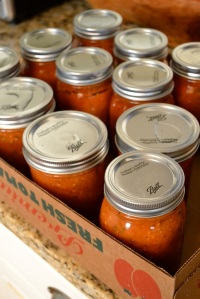



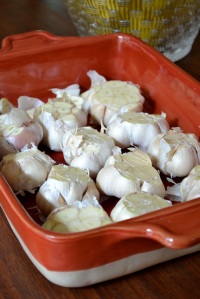

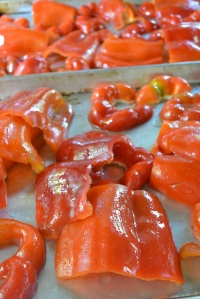






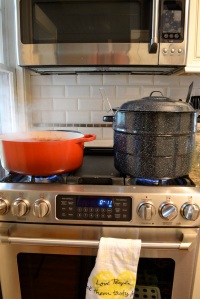

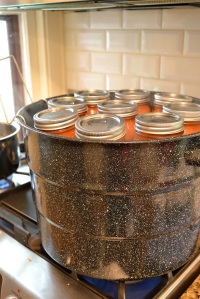

What is a magic wand? I have never canned before but would love to try this!
LikeLike
You should definitely try it! It really is so good and so much better than any canned version you might find. The magnetic wand is simply a plastic stick with a magnet on the end. It can be purchased at Walmart, target or any hardware store with a canning section. It’s purpose is to pull out rings and lids from the simmering water. It is helpful but not necessary!
LikeLike